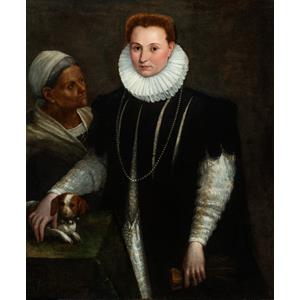DÉTAILS DE L'IMAGE

Nicolás Cortés Gallery
Lavinia Fontana (Bologna 1552–1614 Rome)
Portrait of a Noblewoman with a Servant and Small Dog
Oil on canvas
113 x 92 cm, framed
Provenance: Spinola family, Castello di Pasturana, Piedmont (19th century); sold to Emilia Balduino on 13 June 1933; by descent to the present owner
The attribution of the present painting has been confirmed by Maria Teresa Cantaro after examination of the original painting. Cantaro has dated this work to Fontana’s Roman period between 1604 and 1614, as it displays the artist’s typical use of soft colours with a meticulous sense of drawing and detail. The picture depicts a lady with a servant to her left and a little dog next to her on a table, which the lady caresses with her right hand. Facing the spectator, the sitter exhibits her personality and social status. She wears a silvery-white undergarment, the sleeves of which are embroidered with golden threads, and a dark cloak which only reveals the undergarment in the area around the sleeves and through slits in the area around the chest. Her hair is
combed back and she wears pearl earrings, a single string of pearls around her neck, and a ring on the small finger of her right hand. In her left hand, she holds a pair of gloves. This detail, as well as the dog which is a symbol of connubial fidelity, proclaims the lady’s married status.
With the introduction of the servant, Lavinia Fontana has succeeded in lending this aristocratic portrait a domestic element, mainly seen in Northern Italian genre painting. The figure of the servant recurs in several portraits by the Bolognese artist, such as in Self-Portrait at the Harpsichord with a Servant from 1577 (Galleria dell’Accademia di San Luca, Rome) or in Judith and Holofernes from 1600 (now in the Museo Davia Bargellini, Bologna).
The depiction of aged women was part of the artist’s repertory and can also be found in paintings like The Holy Family with Saints John and Elizabeth (Galleria Borghese, Rome, and a further version in the Stockholm National Museum, both of which date from 1600). The same type of a female figure appears in the Birth of the Virgin (SS. Trinità, Bologna) from 1590.
However, the sharp realism in the execution of the present figure suggests that the present painting dates from a later period and was made in Rome, where the influence of Caravaggio’s realistic style had already achieved recognition. Lavinia arrived in Rome in 1604, in order to complete the altarpiece of The Stoning of Saint Stephen for the church of San Paolo fuori le Mura. In Rome, Fontana, who was held in high esteem by her contemporaries, became a popular and successful portraitist. Baglione, the biographer, reports that the majority of the Roman aristocrats and cardinals had their portraits painted by her.
The present painting may have been commissioned by the Spinola family, who owned it until 1933, when the Castello di Pasturana and its contents were sold to Emilia Balduino, the wife of the Marchese Gavotti. We know of at least one painting by Lavinia Fontana, Saint Francis Worshipping the Cross (today in a private collection in Milan) that was originally in the Spinola Collection.



 TÉLÉCHARGER L'IMAGE
TÉLÉCHARGER L'IMAGE